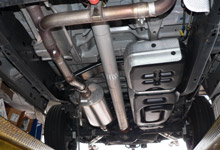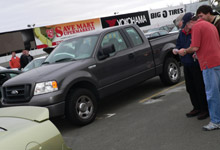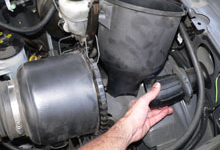
Usually at FordMuscle our
track sessions are limited to weekend test-n-tunes because we're
doing before and after comparisons on some product or another.
Well last Wednesday was different. Work has been a drag and
I wanted to blow off some steam. I heard a friend mention it
was opening night at the local track for the street bracket
racing series. What the heck, I figured it'd be a nice diversion
to take my daily-driver 2006 F150 to the strip. The last time
I took an unsuspecting car to the track I came home with a trophy.
That's the beauty of bracket racing, it doesn't matter how slow
your car is so long as it is consistent.
Since I had a few easy bolt-on modifications laying around waiting
to be tested, I took them along for some quick before and after
testing. I had picked up a K&N replacement filter earlier
in the day since my stock one was really dirty. I also had with
me a new ACCEL DFI Power Processor and some high voltage coil-on-plug
upgrades. Follow along with my step-by-test track tests.
| 1.
Baseline |
17.02 @ 79.9
|
My 2006
F150 STX Supercab weighs somewhere around 5000 lbs. The
231 horsepower 4.6L 2-valve V8 is a carryover from the
previous F150 "heritage" model. While it is
smooth and reliable, it clearly lacks the umph needed
to get all that weight moving quickly. The 5.4L 3V, rated
at 300 HP and 365 lb-ft., is a much better suited motor,
but adds to the price and eats more fuel.
I made a baseline run in near stock form. The only modification
being the Corsa exhaust system we installed previously.
I also arrived at the track with a fresh oil change and
a half-tank full of 91 octane. The result was a sluggish
17.02 at just shy of 80 mph. I kept the transmission in
drive for all runs, letting it shift by itself since the
STX doesn't have a tachometer. I also launched right off
idle and achieved 60ft. times between 2.48 and 2.50 on
all four runs. |

Other than the Corsa exhaust system
we installed
a few months prior, our F150 was in stock form. |

Everyone was interested in how the gray whale performed.
Just kidding, those guys are mulling over a timeslips
from the new Mustang. |
| |
|
| 2.
Ignition Upgrade |
16.97 @ 80.1
|
| In between
timed runs I swapped in these ACCEL Direct Fire coil packs.
They fire at 60,000V versus the stock 20,000V coil packs.
I wasn't expecting much gain but surprisingly they got
me over the 80mph mark and into the 16's. That's about
a half-tenth shavings in ET. The off-idle throttle response
is noticeably crisper as well. For about $180 for the
set I suppose they are akin to a ignition box upgrade
on a traditional distributor using vehicle. |

The ACCEL Direct Fire coil packs for coil-on-plug ignitions
are an easy upgrade to any modular 4.6 or 5.8 motor. |

Replacing the eight coil packs takes nothing but a 7mm
socket and 20 minutes. We gained a solid tenth, and throttle
response is noticeably better off idle. |
| |
|
| 3.
Computer Tuner |
16.80 @ 81.1
|
We baselined
the truck with the factory computer tune. However every
late-model vehicle owner knows that a simple handheld
tuner can pay dividends by modifying the timing, fuel,
shift points and other parameters. We uses ACCEL's new
Ford Power Processor to load up a Premium Fuel program
to the factory computer. Even though this program is meant
for 92 octane we took the risk with California's 91 octane
at the pump.
The results were immediate. In fact this was the only
run where the tires barked off the line. The modified
tune netted a solid 1 mph and over a tenth-and-half off
the ET. |

The ACCEL Power Processor has three "canned"
tuned based on the octane fuel you are using (87, 89,
or 92). You also have the option of tuning all the parameters
yourself. |
 The
Power Processor has a multitude of parameters which can
be manually adjusted. A few to mention are timing, air-fuel
ratio, injector sizing, fan temperature points, and axle
rations. They are all conveniently listed on the back
of the unit. The tunes can be upgraded via the USB port
and downloads from ACCEL-DFI.com The
Power Processor has a multitude of parameters which can
be manually adjusted. A few to mention are timing, air-fuel
ratio, injector sizing, fan temperature points, and axle
rations. They are all conveniently listed on the back
of the unit. The tunes can be upgraded via the USB port
and downloads from ACCEL-DFI.com |
| |
|
| 4.
Air Box Modification |
16.77 @ 82
|
| The final
modification was to put in the new K&N filter. A pretty
simple and easy modification, except that when we opened
up the factory air box we realized some major restrictions
in the tract. The air pickup point in the fender well
narrows down to about 2". Furthermore, in the curved
"box" like section before the throttle body
we noticed a real deception. While the box looks like
it holds a decent volume of air, in fact Ford has stuck
another narrow tube inside it. We removed that with the
hopes for some free horsepower. To our dismay the new
K&N filter and free air box mod didn't yield a whole
lot. Our trap speed hit 82 mph and the ET dropped .03
to 16.77. |

The final modification was the old standby, a K&N
filter. Our factory paper element was sufficiently clogged
up with 14,000 miles of usage. |

The factory air box on the 2004-2007 F-150 4.6L necks
down to a tiny 2.5" opening. There isn't much you
can do about it unless you |

Here's a tip - Ford put a plastic tube in the intake tract.
We suspect the purpose is to reduce sound. With a pair
of pliers and patience you can yank the insert out. The
engine sounds healthier and throttle response is crisper
- but we weren't able to measure any sort of gain in performance. |

While this isn't the ideal setup for the street since
it would draw hot engine compartment air, we were curious
how much we could gain by eliminating the inlet restriction.
Unfortunately we didn't get to try this due to rain. |
We were really curious to learn just how much the narrow pickup
was restricting the engine. Since we didn't have an aftermarket
coil-air intake kit we made a cheap modification by simply removing
the filter cover and clamping the K&N directly to the mass
air housing. Unfortunately light rain called for a rain delay
before we even got into the bracket rounds. We'll have to measure
this mod, and make an attempt for a trophy on an upcoming Wednesday
night. 
|
Posted by john351stang, 11/27/07 02:16pm:
did u try putting everything back to stock at the end of the nite to see how muchthe air gettting better help
|
|
|
|
|
|
|
|
|

